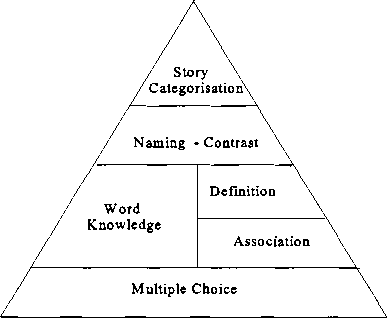As the above diagram shows, during post test 2 the children performed significantly better
on the multiple choice than the other tasks. They performed significantly better on the
association task than the other tasks. In addition they performed significantly better on the
definition than the contrast task. They performed significantly better on the contrast and
short questions (world knowledge questions) than the short questions (categorisation
questions) and story generation task (see Table in Appendix 7.14 for statistical
comparisons).The following Diagram presents children’s success in the tasks during post test
3.
Diagram 7.13 Pattern of success across tasks during post test 3

During post test 3 the children performed significantly better on the multiple choice than the
other tasks. They performed significantly better on the association task than the other tasks.
In addition, they performed significantly better on the short questions (world knowledge
questions) than the naming, contrast, short questions (categorisation questions) and story
generation task. They performed significantly better on the definition than the rest of the
tasks. They performed significantly better on the naming and contrast than the short questions
(categorisation questions) and story generation task (see Table in Appendix 7.15 for the
statistical comparisons).
289
More intriguing information
1. New issues in Indian macro policy.2. Dynamiques des Entreprises Agroalimentaires (EAA) du Languedoc-Roussillon : évolutions 1998-2003. Programme de recherche PSDR 2001-2006 financé par l'Inra et la Région Languedoc-Roussillon
3. The name is absent
4. The role of statin drugs in combating cardiovascular diseases
5. Moi individuel et moi cosmique Dans la pensee de Romain Rolland
6. Forecasting Financial Crises and Contagion in Asia using Dynamic Factor Analysis
7. Getting the practical teaching element right: A guide for literacy, numeracy and ESOL teacher educators
8. Migration and Technological Change in Rural Households: Complements or Substitutes?
9. European Integration: Some stylised facts
10. The Role of area-yield crop insurance program face to the Mid-term Review of Common Agricultural Policy